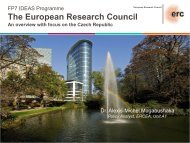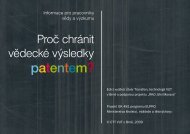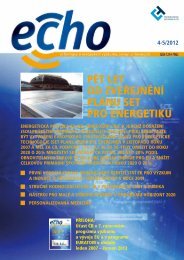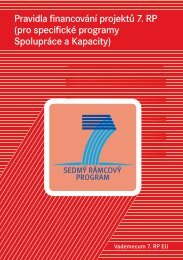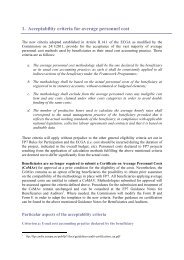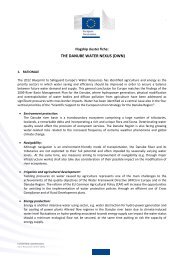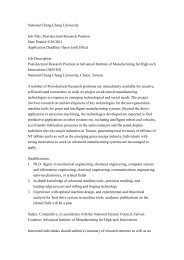Guide to Research and Innovation Strategies for Smart Specialisation
Guide to Research and Innovation Strategies for Smart Specialisation
Guide to Research and Innovation Strategies for Smart Specialisation
You also want an ePaper? Increase the reach of your titles
YUMPU automatically turns print PDFs into web optimized ePapers that Google loves.
• The development of smart specialisation strategies should include the issues of the<br />
market-up-take <strong>and</strong> of public procurement needs among the starting points <strong>for</strong><br />
identifying the fields of specialisation. Funding <strong>for</strong> instance the development of energyefficient<br />
technologies becomes more credible <strong>and</strong> has more impact, if the public sec<strong>to</strong>r<br />
buys them as a lead cus<strong>to</strong>mer <strong>for</strong> applying <strong>and</strong> testing them in practice;<br />
• To encourage procurers <strong>to</strong> purchase innovative solutions by rewarding them <strong>and</strong> by<br />
decreasing the potential innovation costs <strong>and</strong> financial risks through ERDF con-funding;<br />
• To recognise the procurement phase as strategic in public policy cycles, by associating<br />
procurement departments at a early stage in the definition of a project <strong>and</strong> of regional<br />
innovation strategies <strong>for</strong> smart growth;<br />
• To support transparency: <strong>for</strong> the procurers, <strong>to</strong> better know the market <strong>and</strong> stimulate<br />
innovation; <strong>and</strong>, <strong>for</strong> businesses (in particular SMEs) <strong>to</strong> better underst<strong>and</strong> <strong>and</strong> anticipate<br />
the requirements of contracting authorities;<br />
• To support a change in procurement practices <strong>to</strong>wards more dem<strong>and</strong>ing requirements /<br />
specifications <strong>to</strong> pull innovations <strong>to</strong> the market (e.g. related <strong>to</strong> green public procurement<br />
<strong>and</strong> life-cycle-costing) in order <strong>to</strong> encourage the procurer <strong>to</strong> become an 'intelligent'<br />
cus<strong>to</strong>mer 130 . This can be achieved through better prepara<strong>to</strong>ry work <strong>and</strong> capacity building<br />
in procurement offices both regards the identification of state-of-the-art technologies /<br />
solutions in the market <strong>and</strong> regards the capacity <strong>to</strong> manage complex procurement<br />
procedures.<br />
Concrete actions <strong>to</strong> develop<br />
• To support the capacity building of procurement departments through training,<br />
exchanges of civil servants / procurement officers <strong>and</strong> exchanges <strong>and</strong> promotion of good<br />
practices amongst peers 131 (e.g. awarding prizes <strong>for</strong> the best innovation procurement or<br />
methodology 132 ), <strong>and</strong> developing guidance 133 , including sec<strong>to</strong>r orientation such as <strong>for</strong><br />
health 134 , construction 135 , energy efficiency 136 or protective textile 137 , by building<br />
procurers groups <strong>and</strong> networks 138 ;<br />
• To support procurers <strong>to</strong> better engage with the market 139 by involving innovation<br />
agencies 140 , chambers of commerce, cluster organisations / Sec<strong>to</strong>ral plat<strong>for</strong>ms, SME<br />
support organisations (e.g. Enterprise Europe Network 141 ) <strong>and</strong> other bodies that can<br />
assist in developing dem<strong>and</strong>ing specifications;<br />
• To invite <strong>and</strong> guide procurers <strong>to</strong> join <strong>for</strong>ces with others, in order <strong>to</strong> attain critical mass<br />
that makes it interesting <strong>for</strong> firms <strong>to</strong> develop innovative solutions <strong>for</strong> a bid <strong>and</strong> in order<br />
<strong>to</strong> pool capacities (legal, procedural, knowledge on market, technologies <strong>and</strong><br />
per<strong>for</strong>mance levels, administrative budgets <strong>for</strong> the procurement processes, etc.);<br />
130<br />
http://www.proinno-europe.eu<br />
131<br />
http://www.comune.<strong>to</strong>rino.it/relint/PPI/<br />
132<br />
http://lcc.sustainable-procurement.org/<br />
133<br />
http://www.europroc.eu/public/docs/europroc__navigate_change__public_procurement_4fgd.pdf<br />
134<br />
http://lowcarbon-healthcare.eu/<br />
135<br />
http://www.sci-network.eu/fileadmin/templates/scinetwork/files/Resource_Centre/Reports/<strong>Innovation</strong>_in_construction_procurement_-_Preliminary_report.pdf<br />
136<br />
http://www.smart-spp.eu/index.php?id=7633<br />
137<br />
http://www.enprotex.eu<br />
138<br />
http://ec.europa.eu/enterprise/policies/innovation/policy/public-procurement/index_en.htm#h2-1<br />
139<br />
http://www.smart-spp.eu/fileadmin/template/projects/smart_spp/files/D1-<br />
3_report_on_impacts_on_the_market.pdf<br />
140<br />
http://www.proinno-europe.eu/inno-grips-ii/article/fostering-innovation-through-public-procurement<br />
141<br />
http://www.enterprise-europe-network.ec.europa.eu/index_en.htm<br />
102



